

![]()
THE HISTORY OF THE WORKING BORDER COLLIE
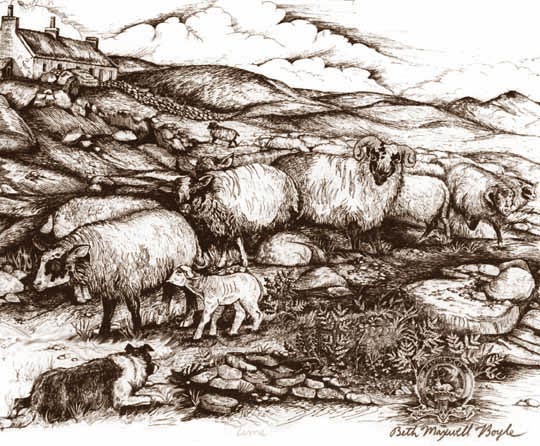
"Lambing Time" by New York State artist, Beth Maxwell Boyle
"Schafe konnen sicher weiden"
("so that sheep may safely graze")---Johann Sebastian Bach, an aria from a secular cantata composed in 1713
Centuries before the industrial revolution, Britain's wealth was built on wool. Domestic sheep were herded by Neolithic man and likely sheepdogs were associated with him as well. The Romans brought pastoral dogs to Britain as they did sheep. Johannes Caius (1510-1573), a doctor working in the Elizabethan Court, mentions the "shepherd's dogge". His book, De Canibus Britannicus (Treatise on Englishe Dogges), may in fact have the earliest reference to the way British sheepdogs worked:
"This dogge either at the hearing of his masters voyce, or at the wagging and whisteling in his fist, or at his shrill and horse hissing bringeth the wandring weathers and straying sheepe, into the selfe same place where his masters will and wishe is to have the[m]...."The truth is, however, the dog he describes could be any collie, perhaps any herding dog. There is no description in his words of the traits that absolutely define the Border Collie: the silent use of "eye" to control the sheep, the crouching creep, the wide-circling outrun to gather the flock. That is not to say that this type of dog didn't exist prior to the 18th century, but there was little record of it; and as a breed, the Border Collie had not yet come into existance.
In Scotland, when a sheep economy took hold, a sheepdog became absolutely necessary. James Hogg (1772-1835), a shepherd and poet from the Ettrick Valley in the Scottish Borders wrote:
"without [the sheep dog] the mountainous land of England and Scotland would not be worth sixpence. It would require more hands to manage a flock of sheep and drive them to market than the profits of the whole were capable of maintaining."
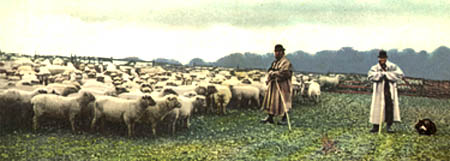
Above, an old tinted photograph from a postcard entitled "Chilly Autumn" shows two shepherds of the English Downs
in their greatcoats and bowler hats, accompanied by their trusty collie.
(Thanks to Mrs. Barbara Carpenter of Pasters Hill House, Gloucestershire, England.)
Sheepdogs varied more in the past than they do today. There were as many types of working dog as there were types of sheep. Most of Britain's types of pastoral dogs have become extinct. Some vanished along with the need for specialized working abilities. Others disappeared when sheep and cattle were no longer being driven to market but were taken by rail, and later truck, obviating the need for a strong driving dog capable of moving large flocks long distances.
In Australia and New Zealand, and in parts of the United States, where there are still huge flocks of sheep and sometimes exceptional conditions, specialized types of sheepdogs have been developed and are still used--heelers, barkers, dogs capable of going over the backs of closely packed sheep or driving them long distances. But in Britain, and in parts of the United States as well, the Border Collie has emerged as the dominant herding dog.
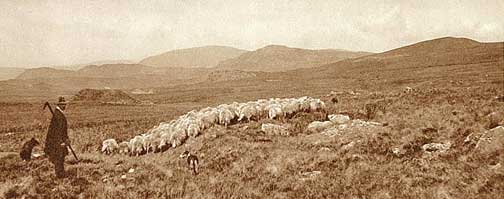
Above, a 1926 photo of a shepherd and two sheepdogs
herding sheep near Ffestiniog, Wales.
Dogs similar to the Border Collie may have existed centuries ago. Old paintings and lithographs show the shepherd's dog as one resembling the Border Collie. However, as Sheila Grew, in her book Key Dogs from the Border Collie Family, Volume II (1985), said:
"A century ago many of the [working] collies were hard, powerful...dogs, difficult to control and rough with...stock; but their keen...instinct,... concentration and great power over...sheep or cattle were such useful assets it seemed worth trying to find a milder natured type of working collie to cross with [them]."
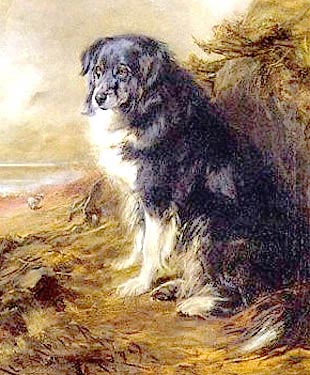 A Northumbrian farmer, Adam Telfer, "succeeded," Grew says, "in finding the right blend of the two types of dog" in 1894. The Border Collie as we know it today is descended from that dog, Hemp 9 (or Old Hemp, as he was known).
A Northumbrian farmer, Adam Telfer, "succeeded," Grew says, "in finding the right blend of the two types of dog" in 1894. The Border Collie as we know it today is descended from that dog, Hemp 9 (or Old Hemp, as he was known).
Left, a sheepdog that looks very much like what Old Hemp must have looked like in his old age, artist unknown. Thanks to
Beth Maxwell Boyle.
Old Hemp is considered the progenitor of the Border Collie breed. The reason he isn't number one in the ISDS stud book is that he was added after the book began and early numbers were already given out. You should also visit the Border Collie Cousins page to see Linda Rorem's Collie Family Tree and read about the interesting genetic study that may actually establish when the Border Collie broke off from the general population of old working collies of Great Britain and Ireland.
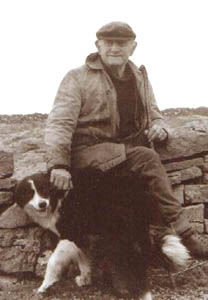
Above, an Irish shepherd and his Border Collie.
WHAT IS A BORDER COLLIE
The Border Collie is defined by its working style. Herding dogs are bred for working ability, and genetic makeup is the biggest factor in determining working characteristics. Each herding breed has somewhat different working behavior depending on the stockmen's needs at the time the breed was being developed. It is the working characteristics of the breed that essentially makes it different from other breeds.
Sheila Grew describes the Border Collie as a "type of herding dog developed by shepherds and sheep farmers during the last hundred years", that is, since the latter part of the 19th century. She goes on to say it is:
"...characterized by its ability to move large or small numbers of sheep in a silent controlled manner in complete co-operation with its master...[and] a most useful asset possessed by many of these border working collies was the power of the 'eye', the ability to control the sheep by staring at them in a fixed and steady manner. Dogs with the right amount of 'eye' can keep their sheep bunched together well when driving them and thus avoid a great deal of flanking, running from one side to the other. This in turn keeps the sheep calmer and so they are less fatigued.. . .
"It was generally known as the 'Working Collie' to distinguish it from the developing show (Lassie) type collie which started to flourish frim 1860 when the first dog show to include farm collies took place in Newcastle.. . .
"The Working Collie was bred for one purpose only in those days--for work..."
The Border Collie is a type of herding dog defined by the perameters below. Bred for both hill and trial work, the Border Collie as a breed, did not come into existance until 1906, when the International Sheep Dog Society (ISDS) was formed and a stud book was opened.
THE CHARACTERISTICS THAT MAKE A HERDING DOG A BORDER COLLIE
Ability to "Gather"
 Left, a shepherd sending his dog out to gather the sheep (artist unknown).
Left, a shepherd sending his dog out to gather the sheep (artist unknown).
Bred for hill conditions, the Border Collie is outstanding when it comes to
working sheep. Unlike "specialists" of the past, the Border Collie is able to
perform a variety of tasks. He is born with the instinct to "gather" the sheep to
the shepherd and this trait makes him most useful on the hill. In Scotland, where
the sheep spend a good part of the year scattered widely on high pasture, a dog
must be able to circle around and gather the entire flock for routine management
like dipping and shearing.
In sheepdog trials, the gather is broken down into three parts. The "outrun" is the first part. The dog is sent by the shepherd or handler to gather the sheep. The dog makes a wide circle around the flock so as to "gather in" the entire flock. In sheepdog trials, there will be only a few sheep, but on the hill it may be the entire flock of hundreds of sheep that needs gathering. This wide circle is called the "outrun". The direction (clockwise or counterclockwise) is determined by the handler and depends on the terrain, the distribution of sheep, and what the handler knows of the dog's strengths and weaknesses (for example, some dogs more naturally go in one direction than the other). While different handlers sometimes use different directional commands, most often "Come-bye!" is the command for clockwise, and "Way to me!" is used for counterclockwise.
The second part of the gather is called the "lift". The dog swings around behind the flock and the flock begins to move off in the direction of the handler. And finally, the third part of the gather, where the dog brings the flock to the handler, is called the "fetch". In sheepdog trials these three parts might be distinctive, but on the hill, especially in difficult terrain, they are probably indistinguishable.
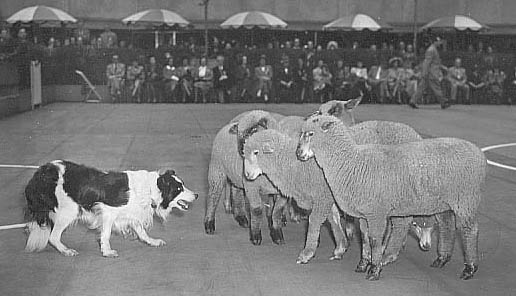
Above, a Border Collie exhibits "eye" during an indoor sheepdog demonstration in
the 1950s.
It is possible that this is Arthur Allen's Imported Rock, an American trialling
champion of that era.
"Eye"
The Border Collie controls the sheep with "eye" which has a distinct meaning, referring to the amount of concentration on the sheep that the dog shows. The sheep are "held" by the strength of the dog's eye and a dog in which this characteristic is well developed is called "strong-eyed". It allows the dog to move the sheep quietly and calmly. It is likely that there were dogs with this behavior early on in the working collie, and, as it is a useful behavior, it was chosen for. James Hogg describes this behavior in his dogs. Eye is the single most distinguishing instinctual behavior of the Border Collie as a herding dog.
"Clapping"
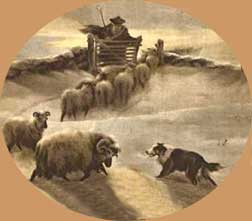 Left, a Border Collie facing a recalcitrant ram by Edwin Douglas.
Left, a Border Collie facing a recalcitrant ram by Edwin Douglas.
The Border Collie has a tendency to "clap" or go down and face the sheep with its
belly close to the ground. This in combination with "eye" gives the Border Collie
a singularly predatory look. Dogs were bred for clapping and strong eye for many
years, but now some are being bred or trained to stay more on their feet so that
they are ready to move quickly if necessary. However, even on its feet, a Border
Collie still crouches forward and has a characteristic predatory appearance.
This combination of behaviors is indeed how preditors hunt and stalk their prey, and herding instinct is often described as "modified prey drive". Sometime back in the murky annals of time, dogs were chosen who could suspend their instincts to kill.
"Intelligence"
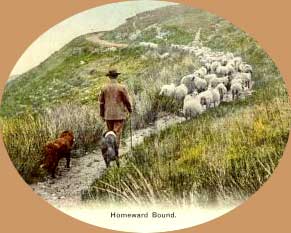 Left, "Homeward Bound" (artist unknown) shows a shepherd with two sheepdogs driving a flock along a hill path.
Left, "Homeward Bound" (artist unknown) shows a shepherd with two sheepdogs driving a flock along a hill path.
Intelligence in an animal that cannot speak is hard to define. The Border Collie
is usually considered an intelligent dog. Stanley Coren (The Intelligence of Dogs, 2005, The Free Press) described intelligence in Border Collies as "trainability", but shepherds had a different definition. To them intelligence meant a dog that could think for himself. Border Collies were often sent great distances to gather the scattered flocks. Because they often had to work far away from their handlers, Border Collies had be intelligent and independent as well. They were relied upon to handle unusual situations without the assistance of the shepherd. Stories abound about how various sheepdogs handled themselves in these instances. Here is one that James Hogg told of his own dog, Sirrah:
I was a shepherd for ten years on the same farm, where I had...about 700 lambs put under my charge...at weaning-time. As they were of the...black-faced breed, the breaking of them was a very ticklish and difficult task. I was obliged to watch them night and day for the first four days, during which I had always a person to assist me. It happened one year, that just about midnight the lambs broke and came up the moor upon us, making a noise with their running louder than thunder. We got up and waved our plaids, and shouted, in hopes to turn them, but we only made matters worse...and by our exertions we cut them into three divisions.
I called out [to my dog] 'Sirrah, my man, they're away'...but owing to the darkness of the night, and the blackness of the moor, I never saw him at all...I ran here and there, not knowing what to do, but always at intervals, gave a loud whistle to Sirrah, to let him know that I was depending on him...We both concluded, that whatever way the lambs ran at first, they would finally land at the fold where they left their mothers, and...we bent our course towards that; but when we came there, we found nothing of them.
My companion then bent his course towards the farm...and I ran away westward for several miles, along the wild track where the lambs had grazed while following their dams. We met after it was day...but neither of us had been able to discover our lambs, nor any traces of them...We had nothing for it but to return to our master, and inform him that we had lost his whole flock of lambs.
On our way home, however, we discovered a body of lambs at the bottom of a deep ravine...and the indefatigable Sirrah standing in front of them, looking all around for some relief, but still standing true to his charge...When we first came in view of them, we concluded that it was one of the divisions of the lambs...But what was our astonishment, when we discovered that not one lamb of the whole flock was wanting! How had he got all the divisions collected in the dark is beyond my comprehension. The charge was left entirely to himself from midnight until the rising of the sun; and if all the shepherds in the Forest had been there to have assisted him, they could not have effected it with greater propriety.
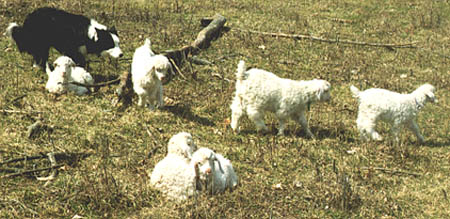
Border Collies can be taught to herd a variety of livestock. Many will naturally herd anything that moves--ducks, chickens, sheep, cats, cars and children. Versatility also makes them excel in fields other than herding and sheepdog trials, and today there are many Border Collies winning Obedience, Agility and Flyball matches for their city and suburban owners.
For more information on the Border Collie and the ISDS see
Sheepdog Trials
in Britain & Ireland.]
And for more on the history of the Border Collie, see
The Working Border Collie in America.]
THE OTHER WEB PAGES WE MAINTAIN
These web pages are copyright ©2014
and maintained by webmeistress Carole Presberg
with technical help from webwizard David Presberg
ALL RIGHTS RESERVED
If you are interested in using ANY material on this website, you MUST first ask for permission.